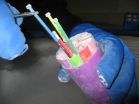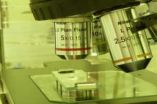(Press-News.org) To discover why Neandertals are most closely related to people outside Africa, Harvard and Max Planck Institute scientists have estimated the date when Neandertals and modern Europeans last shared ancestors. The research, published in the journal PLOS Genetics, provides a historical context for the interbreeding. It suggests that it occurred when modern humans carrying Upper Paleolithic technologies encountered Neandertals as they expanded out of Africa.
When the Neandertal genome was sequenced in 2010 it revealed that people outside Africa share slightly more genetic variants with Neandertals than Africans do. One scenario that could explain this observation is that modern humans mixed with Neandertals when they came out of Africa. An alternative, but more complex, scenario is that African populations ancestral to both Neandertals and modern humans remained subdivided over a few hundred thousand years and that those more related to Neandertals subsequently left Africa.
Dr. Sriram Sankararaman and colleagues measured the length of DNA pieces in the genomes of Europeans that are similar to Neandertals. Since recombination between chromosomes when egg and sperm cells are formed reduces the size of such pieces in each generation, the Neandertal-related pieces will be smaller the longer they have spent in the genomes of present-day people.
The team estimate that Neandertals and modern humans last exchanged genes between 37,000 and 86,000 years ago, well after modern humans appeared outside Africa but potentially before they started spreading across Eurasia. This suggests that Neandertals (or their close relatives) had children with the direct ancestors of present-day people outside Africa.
###
FINANCIAL DISCLOSURE: This work was supported by the Presidential Innovation Fund of the Max Planck Society, the Krekeler Foundation, and the National Science Foundation (HOMINID grant 1032255). The funders had no role in study design, data collection and analysis, decision to publish, or preparation of the manuscript.
COMPETING INTERESTS: The authors have declared that no competing interests exist.
CITATION: Sankararaman S, Patterson N, Li H, Pääbo S, Reich D (2012) The Date of Interbreeding between Neandertals and Modern Humans. PLoS Genet 8(10):e1002947. doi:10.1371/journal.pgen.1002947
PLEASE ADD THIS LINK TO THE FREELY AVAILABLE ARTICLE IN ONLINE VERSIONS OF YOUR REPORT (the link will go live when the embargo ends): http://www.plosgenetics.org/doi/pgen.10029347
CONTACT:
Dr. Sriram Sankararaman
Harvard Medical School
Dept of Genetics
77, Avenue Louis Pasteur
NRB 260
Boston, MA 02115
UNITED STATES
sankararaman@genetics.med.harvard.edu
Disclaimer
This press release refers to an upcoming article in PLOS Genetics. The release is provided by journal staff, or by the article authors and/or their institutions. Any opinions expressed in this release or article are the personal views of the journal staff and/or article contributors, and do not necessarily represent the views or policies of PLOS. PLOS expressly disclaims any and all warranties and liability in connection with the information found in the releases and articles and your use of such information.
About PLOS Genetics
PLOS Genetics reflects the full breadth and interdisciplinary nature of genetics and genomics research by publishing outstanding original contributions in all areas of biology. All works published in PLOS Genetics are open access. Everything is immediately and freely available online throughout the world subject only to the condition that the original authorship and source are properly attributed. Copyright is retained by the authors. The Public Library of Science uses the Creative Commons Attribution License.
About the Public Library of Science
The Public Library of Science (PLOS) is a non-profit organization of scientists and physicians committed to making the world's scientific and medical literature a freely available public resource. For more information, visit http://www.plos.org.
2pm Pacific/5pm Eastern Time/10pm GMT
Everything published by PLOS Genetics is open access, allowing anyone to download, reuse, reprint, modify, distribute, and/or copy articles, so long as the original authors and source are cited. Please mention PLOS Genetics in your report and use the link(s) below to take readers straight to the online articles. Thank you. END
Dating encounters between modern humans and Neandertals
To discover why Neandertals are most closely related to people outside Africa scientists have estimated the date when Neandertals and modern Europeans last shared ancestors
2012-10-05
ELSE PRESS RELEASES FROM THIS DATE:
BPA's real threat may be after it has metabolized
2012-10-05
Bisphenol A or BPA is a synthetic chemical widely used in the making of plastic products ranging from bottles and food can linings to toys and water supply lines. When these plastics degrade, BPA is released into the environment and routinely ingested.
New research, however, from the University of California, San Diego School of Medicine suggests it is the metabolic changes that take place once BPA is broken down inside the body that pose the greater health threat.
More than 90 percent of all Americans are believed to carry varying levels of BPA exposure.
In recent ...
Insects shape the genetic landscape through plant defenses
2012-10-05
As restaurant patrons' diverse food preferences give rise to varied menu offerings, so plant-eating insects' preferences play an important role in maintaining and shaping the genetic variation of their host plants in a geographic area, reports an international team of researchers that includes a plant scientist at the University of California, Davis.
The new study, involving aphids and the broccoli-like research plant Arabidopsis thaliana, provides the first measureable evidence that this selective process is driven, in part, by the pressure that multiple natural enemies ...
14 new biomarkers identified for type 2 diabetes
2012-10-05
Potsdam-Rehbruecke/Berlin – A research team led by Anna Floegel of the German Institute of Human Nutrition (DIfE) and Tobias Pischon of the Max Delbrueck Center for Molecular Medicine (MDC) has identified 14 novel biomarkers for type 2 diabetes. They can serve as basis for developing new methods of treatment and prevention of this metabolic disease. The biomarkers can also be used to determine diabetes risk at a very early point in time. At the same time the markers enable insight into the complex mechanisms of this disease, which still have not been completely elucidated. ...
Asteroid fragments could hint at the origin of the solar system
2012-10-05
The tiny pieces of rock – at 50-100 micrometers smaller than a human hair – have been captured from asteroid Itokawa by the Japanese mission Hayabusa. They were carefully unpacked by experts at the University's School of Earth, Atmospheric and Environmental Sciences.
It is the first time samples from an asteroid have been returned to Earth. Only about 70 samples have been released for international analysis – seven of these are being studied at the University.
The Hayabusa mission is part of a continuing effort to understand how asteroids, which are leftovers from ...
Everyday evolution
2012-10-05
Take a good look around on your next nature hike. Not only are you experiencing the wonders of the outdoors – you're probably also witnessing evolution in action.
New research from the University of Toronto Mississauga (UTM) on the effect of insects on plant populations has shown that evolution can happen more quickly than was previously assumed, even over a single generation. The study is to be published in the Oct. 5 issue of Science.
"Scientists have long hypothesized that the interaction between plants and insects has led to much of the diversity we see among plants, ...
Abortion rates plummet with free birth control
2012-10-05
Providing birth control to women at no cost substantially reduced unplanned pregnancies and cut abortion rates by 62 percent to 78 percent over the national rate, a new study shows.
The research, by investigators at Washington University School of Medicine in St. Louis, appears online Oct. 4 in Obstetrics & Gynecology.
Among a range of birth control methods offered in the study, most women chose long-acting methods like intrauterine devices (IUDs) or implants, which have lower failure rates than commonly used birth control pills. In the United States, IUDs and implants ...
How ketamine defeats chronic depression
2012-10-05
Many chronically depressed and treatment-resistant patients experience immediate relief from symptoms after taking small amounts of the drug ketamine. For a decade, scientists have been trying to explain the observation first made at Yale University.
Today, current evidence suggests that the pediatric anesthetic helps regenerate synaptic connections between brain cells damaged by stress and depression, according to a review of scientific research written by Yale School of Medicine researchers and published in the Oct. 5 issue of the journal Science.
Ketamine works on ...
UCLA astronomers discover star racing around black hole at center of our galaxy
2012-10-05
UCLA astronomers report the discovery of a remarkable star that orbits the enormous black hole at the center of our Milky Way galaxy in a blistering 11-and-a-half years — the shortest known orbit of any star near this black hole.
The star, known as S0-102, may help astronomers discover whether Albert Einstein was right in his fundamental prediction of how black holes warp space and time, said research co-author Andrea Ghez, leader of the discovery team and a UCLA professor of physics and astronomy who holds the Lauren B. Leichtman and Arthur E. Levine Chair in Astrophysics. ...
Climate sceptics more prominent in UK and US media
2012-10-05
Climate sceptics are being given a more prominent, and sometimes uncontested, voice in UK and US newspapers in contrast to other countries around the world, new research suggests.
The findings have been published today, 5 October, in IOP Publishing's journal Environmental Research Letters, as part of a study looking at how climate scepticism manifested itself in the print media of the US, UK, Brazil, China, India and France during a 3-month period which included 'Climategate' in 2009/10 and a second period which covered the IPCC's Fourth Assessment Report in 2007.
In ...
Maths sheds light on what delays in getting pregnant means for prospects of having a baby
2012-10-05
A new mathematical method can help to predict a couple's chances of becoming pregnant, according to how long they have been trying.
The model may also shed light on how long they should wait before seeking medical help.
For example, the researchers have found that, if the woman is aged 35, after just six months of trying, her chance of getting pregnant in the next cycle is then less than 10 per cent.
The analysis, developed at Warwick Medical School at the University of Warwick and the London School of Economics, uses the number of menstrual cycles over which the ...
LAST 30 PRESS RELEASES:
Making lighter work of calculating fluid and heat flow
Normalizing blood sugar can halve heart attack risk
Lowering blood sugar cuts heart attack risk in people with prediabetes
Study links genetic variants to risk of blinding eye disease in premature infants
Non-opioid ‘pain sponge’ therapy halts cartilage degeneration and relieves chronic pain
AI can pick up cultural values by mimicking how kids learn
China’s ecological redlines offer fast track to 30 x 30 global conservation goal
Invisible indoor threats: emerging household contaminants and their growing risks to human health
Adding antibody treatment to chemo boosts outcomes for children with rare cancer
Germline pathogenic variants among women without a history of breast cancer
Tanning beds triple melanoma risk, potentially causing broad DNA damage
Unique bond identified as key to viral infection speed
Indoor tanning makes youthful skin much older on a genetic level
Mouse model sheds new light on the causes and potential solutions to human GI problems linked to muscular dystrophy
The Journal of Nuclear Medicine ahead-of-print tip sheet: December 12, 2025
Smarter tools for peering into the microscopic world
Applications open for funding to conduct research in the Kinsey Institute archives
Global measure underestimates the severity of food insecurity
Child survivors of critical illness are missing out on timely follow up care
Risk-based vs annual breast cancer screening / the WISDOM randomized clinical trial
University of Toronto launches Electric Vehicle Innovation Ontario to accelerate advanced EV technologies and build Canada’s innovation advantage
Early relapse predicts poor outcomes in aggressive blood cancer
American College of Lifestyle Medicine applauds two CMS models aligned with lifestyle medicine practice and reimbursement
Clinical trial finds cannabis use not a barrier to quitting nicotine vaping
Supplemental nutrition assistance program policies and food insecurity
Switching immune cells to “night mode” could limit damage after a heart attack, study suggests
URI-based Global RIghts Project report spotlights continued troubling trends in worldwide inhumane treatment
Neutrophils are less aggressive at night, explaining why nighttime heart attacks cause less damage than daytime events
Menopausal hormone therapy may not pose breast cancer risk for women with BRCA mutations
Mobile health tool may improve quality of life for adolescent and young adult breast cancer survivors
[Press-News.org] Dating encounters between modern humans and NeandertalsTo discover why Neandertals are most closely related to people outside Africa scientists have estimated the date when Neandertals and modern Europeans last shared ancestors




